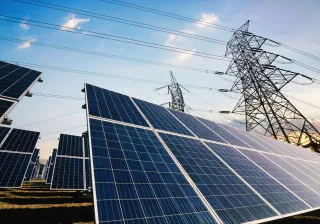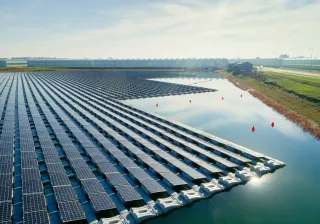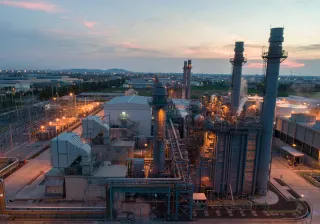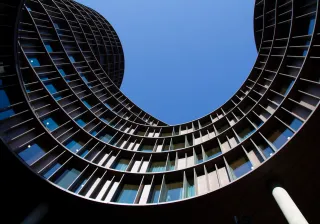District heating is energy distribution technology that enables the efficient, economical utilisation of local heat production and, according to recent research results, with ever-lower emissions in the future.
District heating plays a key role in Finland: more than 90% of the residents of larger cities already live in buildings with district heating. According to D.Sc. (Tech.) Miika Rämä, who focused on developing district heating systems in his doctoral dissertation, the benefits of district heating are most pronounced in densely populated urban areas where the relative heat loss of the district heating network is small.
– To put it simply: the fewer metres of pipe you need per each unit of thermal energy consumed, the more efficient the distribution network is both economically and technically, says Rämä, head of a VTT research team.
According to Rämä, lower temperatures in the distribution network could promote the utilisation of renewable heat sources and waste heat. At the same time, it would further reduce heat loss during distribution and improve the efficiency of the heat sources connected to the system.
– Both heat pumps and solar thermal collectors benefit from low distribution temperatures, and it will also make it more efficient to recover heat from power plant processes and excess heat sources, he adds.
Key factor of the energy transition
Rämä estimates that district heating can play a very important role in the energy transition in urban areas and in combating climate change in the future. District heating will be seen as an increasingly important part of urban infrastructure, as it will enable more extensive utilisation of local heat sources and the recovery of waste heat in the future.
– Heating and cooling solutions are naturally included in the intelligent energy system of the Smart City concept, and district heating in urban areas is a part of it. District heating makes it possible to implement the sectoral integration of electricity and heat on a large scale and in a cost-effective way. Recycling heat in the spirit of circular economy also makes more sense at the urban level thanks to the district heating network.
The clearest development target for district heating systems is the shift towards so-called fourth generation district heating systems.
– This means flexible heat generation based on low-carbon solutions, a low-temperature distribution network that improves the feasibility of these solutions, and integration with the electricity system. At the same time, it means being included in other long-term planning processes, such as urban planning, says Rämä.
According to Rämä, lowering the temperature in the distribution network is the most important individual objective.
– In terms of district heating, it requires actions in the heat distribution systems of buildings, which means expanding the traditional area of responsibility for district heating companies. The costs of the transition are mainly focused on buildings, and the benefits will mainly be seen in heat production. As the costs and benefits fall on different stakeholders (customers, district heating company) we need new, transparent business models to correct this imbalance in order to share the benefits and costs in a fair way between customers and providers.
Low-carbon trend
One future trend is the increasing use of low-carbon heat sources in district heating production. Low-carbon heat production could be based on biomass, solar heat, and using other natural heat sources. Options include the growing use of waste heat from industrial plants and the introduction of nuclear district heating.
– In general, the trend in heat production is towards electrification and away from combustion.
The umbrella of biomass covers wood chips, biogas, biofuels and liquid biofuels. In this respect, availability is a key factor, since other industries are competing for the raw materials alongside the heating sector.
According to Rämä, heat pumps are clearly a key technology in the utilisation of heat sources. They include a significant number of different implementation methods, depending on the properties of the actual heat source, such as geothermal energy. One interesting prospect for heat pumps is to combine the production of heating and cooling. This solution has been used in Finland for long already, for example in Helsinki and Turku.
Using waste heat is an interesting prospect, particularly in urban areas. Especially with industrial waste heat, temperatures may be so high that a heat pump is not necessary.
Nuclear district heating, on the other hand, is interesting nowadays especially in the form of small modular reactors (SMR) rather than large nuclear power plants. The main challenges of district heating with nuclear power are related to developing regulations, ensuring safety, and gaining social acceptability.
– As an alternative, nuclear district heating is technically feasible, even though commercial SMR concepts are still under development. Still, the emission-reducing potential of this technology is undeniable and therefore an essential option for the future.
Many alternatives for developing district heating
In addition to developing technologies, it is at least equally important to find a suitable combination of different low-carbon forms of heat production and ways of reducing emissions. Especially in larger urban district heating systems, no single form of production can be the only solution.
Alongside forms of production, attention should also be paid to the energy efficiency of buildings and heat distribution systems, the flexibility of heat demand, energy storage solutions, and improved efficiency of distribution network, as well as local resources in general, whether they be heat sources or fuels.
In addition, it may be possible to utilise waste heat from sources such as industry and data centres more than before.
– At the same time, the system should be flexible and act in tandem with varying electricity production that's based on renewable energy, so that we can balance the demand and supply of electricity.
The playing field of district heating development will most likely keep growing, and it will not be limited to comparing production technologies alone.
– Technologies will certainly continue to evolve, but I believe that this type of systemic thinking will become even more prominent.
Did you know...
The market share of district heating in Finland is 46% (2019), and in larger cities in particular, more than 90% of residents live in buildings with district heating. In terms of energy, the largest consumer of district heating is China, and district heating is most commonly used in the Nordic countries, Russia, and Eastern Europe.
The production form of district heating plays a crucial role in terms of total emissions, but the energy efficiency of buildings, their heat distribution solutions, and the temperature level of the district heating distribution network also have a central role.
Managing benefits and costs in a fair and transparent way is a prerequisite for shifting to lower distribution temperatures. The benefits are reflected in the production and distribution of heat (district heating company), but the costs are mainly focused on the changes that need to be made in buildings (customers).
– In the future, lower distribution temperatures will require closer temperature management in the distribution network, which in turn highlights the importance of simulation tools in both planning and operational processes, says Miika Rämä.
Text: Nina Garlo-Melkas









